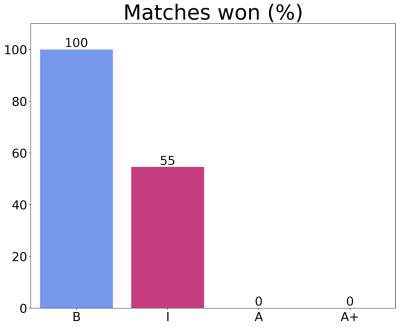A team at Google has spent a lot of time recently playing table tennis, purportedly only for science. Their goal was to see whether they could construct a robot which would not only play table tennis, but even keep up with practiced human players. In the paper available on ArXiv, they detail what it took to make it happen. The team also set up a site with a simplified explanation and some videos of the robot in action.

In the end, it took twenty motion-capture cameras, a pair of 125 FPS cameras, a 6 DOF robot on two linear rails, a special table tennis paddle, and a very large annotated dataset to train multiple convolutional neural networks (CNN) on to analyze the incoming visual data. This visual data was then combined with details like knowledge of the paddle’s position to churn out a value for use in the look-up table that forms the core of the high-level controller (HLC). This look-up table then decides which low-level controller (LLC) is picked to perform a certain action. In order to prevent the CNNs of the LLCs from ‘forgetting’ the training data, a total of 17 different CNNs were used, one per LLC.
The robot was tested with a range of players from a local table tennis club which made clear that while it could easily defeat beginners, intermediate players pose a serious threat. Advanced players completely demolished the table tennis robot. Clearly we do not have to fear our robotic table tennis playing overlords just yet, but the robot did receive praise for being an interesting practice partner.
















I think you meant a convolutional neural network, though a convolutional network network sounds pretty convoluted, all right!
I remember this table tennis robot:
https://www.youtube.com/watch?v=imVNg9j7rvU
This is CGI, its quite well done though
That is true, it is computer generated image (CGI) animation ;-)
It might be inspire the google team achieve the same elegance with a smaller robot.
Brilliant project, but the video is the size of a postage stamp. Why such a strange video size?
Very strange, ai generated? :p Seriously, the video does not convince me it can keep up with practiced players.
General years back I went to a trade show and they had a computer controlled table tennis robot that absolutely trounced everyone who played it. It was a demo for Osram sensors I think.
This video is not very convincing, yet i am getting trashed by regular training bots lol
It really does look like a stop motion animation which I find a little disconcerting.
It’s unfair since the robot has different anatomy. A human controlling a robotic arm might win.
And a robot with a humanoid arm might lose. Still interesting though.
I’ll wager that by this time next year, they’ll be beating very good players.
That seems to be the advancement rate with AI stuff in general:
– one year, they’re able to do something poorly
– the next year, they’re able to do it well
– the next year, they’re beating experts
Of course, this task might be more difficult due to the physical/latency limitations.
What I found interesting is that the robot that is supposed to be able to beat casual players is never shown serving. While the ability to return a serve might be impressive, not being able to serve would make me think it’s incapable of beating anyone.